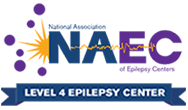Epilepsy - Vagus Nerve Stimulation
Vagus Nerve Stimulation or VNS is a procedure used to control epileptic seizures.
It involves the use of a small device about the size of a silver dollar which sends mild, electrical impulses to the brain via a nerve in the neck called the vagus nerve.
The generator, which is implanted under the skin behind your neck, delivers 30-second pulses of electricity to the vagus nerve every five minutes. These pulses block the electrical disturbances in the brain.
When a patient feels that they are about to have a seizure, they can hold a small magnet over the generator to activate the electrical pulses.
Who is a Candidate?
Patients who suffer from partial seizures, and don't have other serious medical conditions, are considered good candidates for VNS.
About 80 percent of all epilepsy patients get the relief they need from medication. However, for the 20 percent who don't respond well to drugs and are unable or unwilling to undergo surgery, VNS is considered a viable alternative.
The University of Maryland Medical Center is one of a select number of places in the country where patients can see a multi-specialty team of experts for neurological, surgical, rehabilitative and psychosocial treatments of seizure disorders. All patients receive continuous electronic monitoring and evaluation.
Why Stimulate the Vagus Nerve?
The vagus nerve is one of the 12 cranial nerves that originate in the brain. The nerve fibers in the vagus carry information to and from the brain to the larynx, the heart, the stomach, lungs and esophagus. Researchers think that the vagus nerve is also connected to the limbic structures in the brain, which are associated with the regulation of mood.
Experts focus on the vagus nerve for epilepsy treatment for a couple of reasons. First of all, in addition to being connected to many organs in the body, it is also connected to areas of the brain likely to develop seizures. Secondly, unlike other nerves, it doesn't have many pain fibers. Therefore, it can deliver electricity to targeted areas without requiring any surgery on the brain itself.
The Procedure
To implant the device, surgeons make a small incision in the neck and one below the collarbone.
Once the battery-operated, electrical pulse generator is implanted, a flexible, insulated plastic tube containing electrodes is run under the skin to the vagus nerve on the left side of the neck.
It usually takes about an hour, and can sometimes be done on an outpatient basis.
The entire device can last up to 12 years, but the battery-operated generator only lasts about six years.
Risks
The possible risks of VNS include injury to the vagus nerve, which can lead to a hoarse speaking voice, coughing or difficulty swallowing.
Other complications include injury to the carotid artery or internal jugular vein, and, as with other surgical procedures, there is always the risk of infection at the site where the generator is implanted.
Vagus Nerve Stimulation for Depression
VNS is also being used to treat those with severe, treatment-resistant depression. Depression is a serious psychiatric disorder that affects about 18 million Americans. While most people with depression are treated successfully with conversational therapy and medication, about one million of them don't respond to these treatments.

